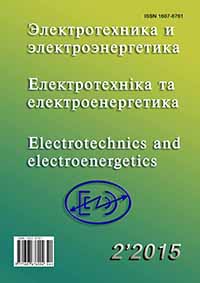CALCULATION OF TRANSIENTS IN TRANSFORMER ON THE BASIS OF MAGNETO ELECTRICAL EQUIVALENT SCHEMES WITH THE USE OF TCHEBYSHEV’S POLYNOMIALS
DOI:
https://doi.org/10.15588/1607-6761-2015-2-1Keywords:
Tchebyshev’s polynomials, transients, scheme interpretation, magneto-electrical circuitsAbstract
Transient modeling in transformers is presently executed by formation and solution of the state equations for the magneto-electrical equivalent schemes. These processes can be very long, that results in a considerable time of calculation at the modern software use. The aim of the given work is the development of more fast-acting method of calculation of electromagnetic transients in transformers, using solution approximation by polynomials, and also development of comfortable scheme model of method for putting into practice. On the basis of solution approximation of the state equations by the Tchebyshev’s polynomials the method of transients calculation in magneto-electrical equivalent schemes is worked out. Scheme interpretation of the developed method is offered. It is shown that in the special equivalent scheme the Kirchhoff’s laws are fair for the images of currents and magnetic fluxes as vectors, containing the values of coefficients of decomposition of these values by the Tchebyshev’s polynomials. This method allows to replace operations with the instantaneous values of currents by operations with direct currents in offered equivalent scheme. As a result the integrodifferential state equations are submitted by algebraic equations. The calculation with the offered method of transient in a three-phase transformer processor allows to reduce time more than twice as compared to calculations with the help of the well-known methods. The given method is especially comfortable for the transient’s calculation in magneto-electrical circuits, since it allows to use voltage sources controlled by the current derivative as well as easily evaluate the integrals of solutionReferences
Васильев Н. И. Применение полиномов Чебышева в численном анализе. / Н. И. Васильев, Ю. А. Клоков, А. Я. Шкерстена. – Рига.: Зинатне. – 1984. – 240 с.
Татевян С. К. Численное интегрирование обыкновенных дифференциальных уравнений с использованием рядов Чебышёва. / С. К. Татевян , Н. А. Сорокин, С. Ф. Залеткин Вычислительные методы и программирование.– 2002.” Т.3, с. 52–81.
Пашковский С. Вычислительные применения многочленов и рядов Чебышева / С. Пашковский . – М.: Наука, ГРФМЛ, 1983 . – 384 с.
Ильина В. А. Численные методы для физиков-теоретиков.1. / В. А. Ильина, П. К. Силаев. – Москва-Ижевск: Институт компьютерных исследований. – 2003. – 132 с.
Данилов Ю. А. Многочлены Чебышева / Ю. А. Данилов. – Минск.: Вышэйшая школа, 1984 . – 157 с.
Бахвалов Н. С. Численные методы / Н. С. Бахвалов, Н. П. Жидков, Г. М. Кобельков. – М.: Наука, 1987 . – 630 с.
Тиховод С. М. Модификация магнитоэлектрических схем замещения электромагнитных устройств для анализа переходных процессов / С. М. Тиховод // Электричество. – 2014. – №2. – С. 53–60.
Помощь студентам-электрикам. Научные разработки, программы. Программы для расчета переходного процесса в трехфазном трансформаторе.–[Электронный ресурс] . – режим доступа: http://www.electricity.zp.ua/
Dommel Hermann W. EMTP theory book / Hermann W. Dommel. – British Columbia.: Microtran Power System Analysis Corporation Vancouver, 1996. – 631 p.
Downloads
How to Cite
Issue
Section
License
Copyright (c) 2017 S. M. Tikhovod

This work is licensed under a Creative Commons Attribution 4.0 International License.
Creative Commons Licensing Notifications in the Copyright Notices
Authors who publish with this journal agree to the following terms:
Authors retain copyright and grant the journal right of first publication with the work simultaneously licensed under aCreative Commons Attribution License that allows others to share the work with an acknowledgement of the work's authorship and initial publication in this journal.
Authors are able to enter into separate, additional contractual arrangements for the non-exclusive distribution of the journal's published version of the work (e.g., post it to an institutional repository or publish it in a book), with an acknowledgement of its initial publication in this journal.
Authors are permitted and encouraged to post their work online (e.g., in institutional repositories or on their website) prior to and during the submission process, as it can lead to productive exchanges, as well as earlier and greater citation of published work.

